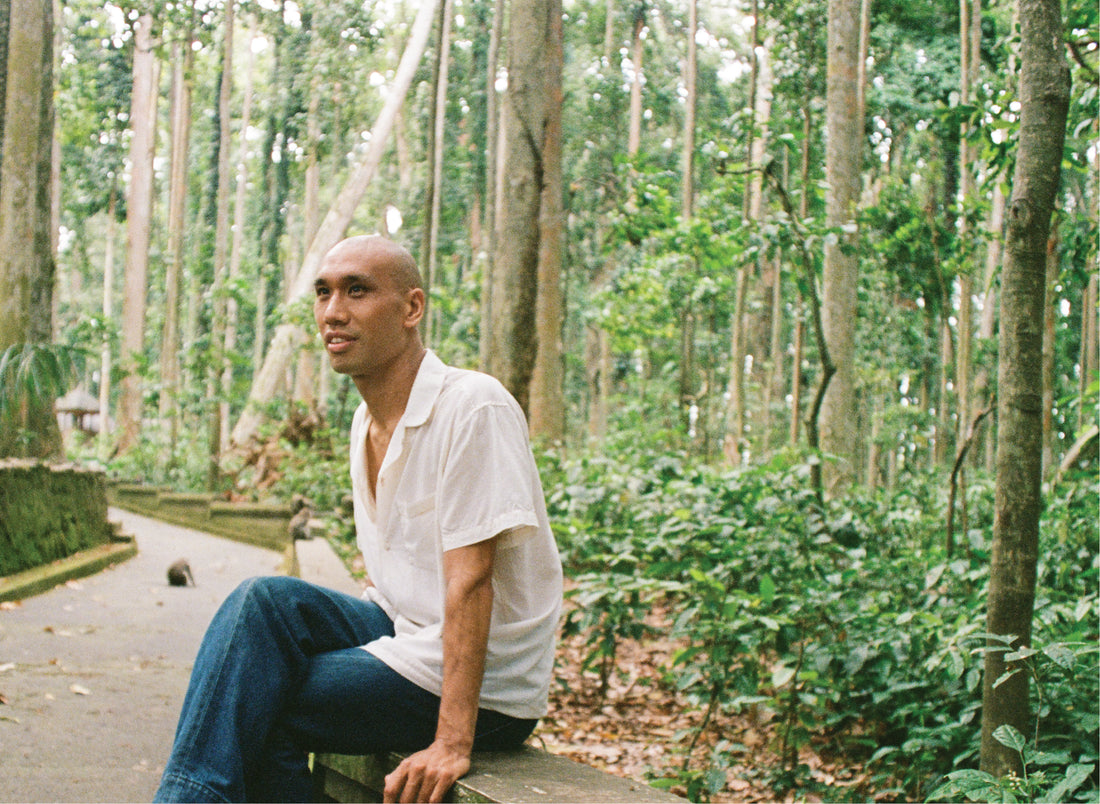2017 marks the year of transformation for Zhi Xiong Chan. In London, he started an architecture and interior design practice under the name ZXC Studio. But it was not until he moved to Bali that this explorative, collaborative, and sensory driven studio flourished.
We talked to Zhi Xiong Chan about movement and people; how these two elements enrich a space and transform it into a place.
Xiong, as everyone calls him, chose a tucked in monkey forest in Badung for the interview. He arrived at around 3 in the afternoon, in his blue jeans and white shirt. Relaxed, maybe looking a little nervous, but so eloquent in expressing his affinity for movement, collaborative work, and his dog.

How do you usually start your day?
Starting a few weeks ago, I started doing ashtanga yoga. Since then, I have been practicing yoga for 2 hours every morning. Anything that keeps me moving and awake.
Why did you choose to be an architect?
I used to draw a lot and play with building blocks and stuff when I was a kid. I grew up in London, but my family is from Malaysia. So we visited Malaysia quite often and I had an uncle who was an architect in Sarawak.
He was the one that encouraged me to be an architect as he saw that I enjoy drawings. So everytime we visited Malaysia, he would take me around. In those little trips, I saw how he transformed things. He had a kind of old rundown town house. When I was around 8, he renovated it and I was fascinated by the way he transformed the house into like no other house that I had ever seen. From this point in time I started to be aware and curious about architecture and design.

Where did ZXC Studio start and why did you decide to start a studio?
Around 2016 or 2017, I was doing freelance work in London. So I started the studio just so I could join some architecture competition. But I actually did not end up completing or submitting my entry in the end. It was really when I moved to Bali that I started doing work through ZXC Studio.
What brought you to Bali?
Actually I didn't have any ambition to move to Bali before. I had some friends who were producing clothes here. They lived between here and Europe and they had friends that needed an architect to build something. Then they were kind of asking me to be here. I did not know how serious it was. You know, friends...
They were connected to people who needed an architect to help with some projects here in Bali and were encouraging me to take them on. It happened to be when I was traveling so I sent my portfolio without any expectation and a few months later I ended up to move here.
I have traveled a bit around Indonesia; from Bali to Mount Rinjani in Lombok. So I did not expect much. But somehow I got connected with people in Bali. Then it continued from there.

You did some capoeira and you enjoyed hiking in the mountains. How does movement influence your work as an architect?
I think movement is related to space, right? Because you're always moving within some kind of physical space. I guess I always think of what it's like to be in that space; to move around in that space. Then I try to configure that movement into comfort and experience; what it is gonna be like in the space that you're creating. I think also the collaboration with artists has to resonate with the project and enhance the space in a way that architecture or interior design cannot do. I use that as more of a starting point. How is it like to experience that space? What kind of forms can we create from that? What things that you want people to see, things you want to hide from people?
To me, your design seems to be intimate, relaxed, but also very detailed to texture. What's the role of texture in your design?
Texture is part of the experience. It’s the part that your body touches when you’re in that space and it also affects the way light and sound is reflected from a surface. So I think all of those things; texture, colors, the size of the space, the light, even the smell, it’s just another layer of the design. All of it is about creating the experience; it depends on what the space wants you to feel. How does it feel to move in this space?
Your work with other artists and interior designers, like Kanoko and Eva Natassa, how is your process in choosing or working with others?
It’s always nice to have that relationship with space and time. Like Kanoko is such a productive artist here at this moment. So it gives the work the context; where the space is, when that space was established.
- for example Kanoko has a more outwardly playful, sentimental and intuitive approach but we can also align in the use of textures and colors.


What’s your favorite way to move?
Capoeira. I’ve been doing it for about 6 years. I started when I was a teenager; but very briefly in London. Then I started again a little bit before I moved to Bali.
How do you enjoy your day off?
I always do yoga in the morning. I do a bit of skateboarding too and driving around places with my dog :D
What music are you listening to these days?
Brazilian pop. Also Japanese and Korean Pop. Anything really.

What are your favorite places in Bali?
For trekking or hiking, Gunung Abang is a nice one. Gunung Agung obviously.
For other places to be closer to nature in Bali, it’s Sidemen for me. It has a kind of tourist stuff, but it feels like the tourism is "settled". They have enough, but they don’t have too much. So it’s nice and chill. I think the east coast is kind of that way; Sidemen, Manggis, Candidasa.
I also like the north coast. Singaraja. Tejakula. Because there’s nothing much there, but you can just be.
written by Prinka Saraswati
photos by Michael Madrid

